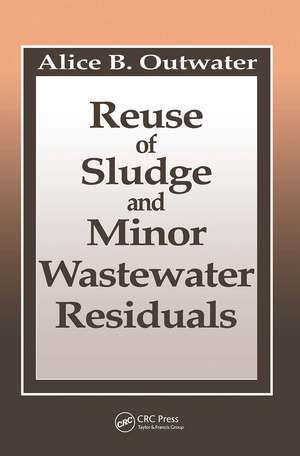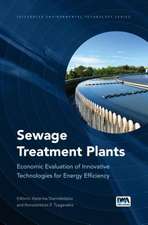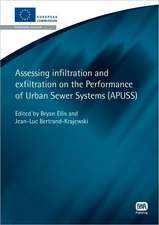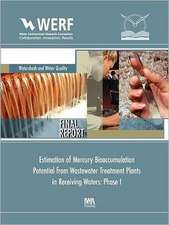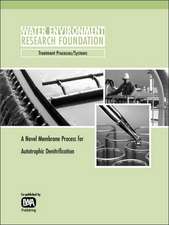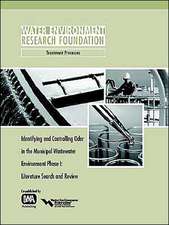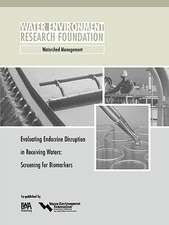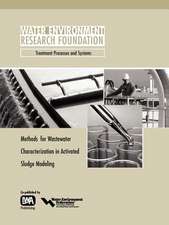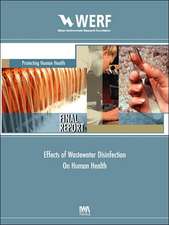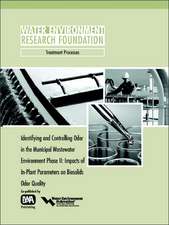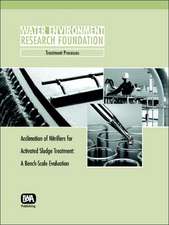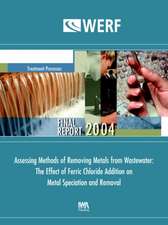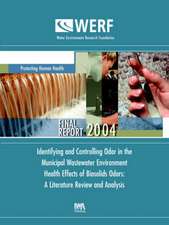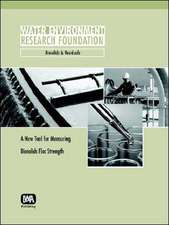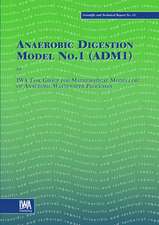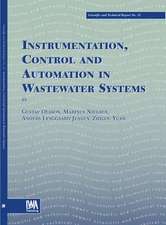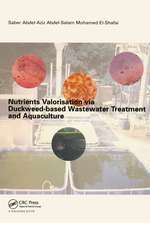Reuse of Sludge and Minor Wastewater Residuals
Autor Alice Outwater, Berrin Tanselen Limba Engleză Hardback – 15 iun 1994
Preț: 1056.71 lei
Preț vechi: 1288.67 lei
-18% Nou
Puncte Express: 1585
Preț estimativ în valută:
202.22€ • 219.59$ • 169.87£
202.22€ • 219.59$ • 169.87£
Carte tipărită la comandă
Livrare economică 22 aprilie-06 mai
Preluare comenzi: 021 569.72.76
Specificații
ISBN-13: 9780873716772
ISBN-10: 0873716779
Pagini: 192
Ilustrații: 74 tables and 11 equations
Dimensiuni: 156 x 234 x 13 mm
Greutate: 0.51 kg
Ediția:1
Editura: CRC Press
Colecția CRC Press
ISBN-10: 0873716779
Pagini: 192
Ilustrații: 74 tables and 11 equations
Dimensiuni: 156 x 234 x 13 mm
Greutate: 0.51 kg
Ediția:1
Editura: CRC Press
Colecția CRC Press
Public țintă
ProfessionalCuprins
1. Introduction -- 1. 1. Sludge Production in the United States -- 1.2. Benefits of Reusing Sewage Sludge -- 1.3. Constraints for Sewage Sludge Reuse -- 1.3.1. Improving Sludge Quality -- 1 .4. A Guide to Sludge Reuse Program -- 2. Sludge -- 2.1. Sludge Characterization -- 2.1.1. Physical Composition -- 2.1.2. Chemical Composition -- 2.2. Sludge Production -- 2.3. Sludge Sampling -- 2.3.1. Digester Stratification -- 2.3.2. Industrial Contributions -- 2.3.3. Laboratory Error -- 2.4. Analytical Characterization of Sludge -- 2.4.1. Mass Balances of Contaminants -- 2.4.2. Theoretical Removal Rates of Contaminants -- 3. Improving Sludge Quality -- 3.1. Introduction -- 3.2. Calculating Influent Loadings -- 3.3. Quantifying Sources of Contaminants -- 3.3.1. WaterSupply -- 3 .3 .1.1. Lang lier Saturation Index -- 3.3.1.2. Aggressive Index -- 3.3.1.3. Reducing the Metals Attributable to the Water Supply -- 3.3.2. Industrial Contributions -- 3.3.2.1. Sewer Use Limitations -- 3.3.2.2. Industrial Loadings -- 3.3.3. Households -- 3.3.4. Run-Off -- 3.3.5. Leachate from Landfills and Hazardous Waste Sites -- 3.4. Case Study -Sources of Petroleum Hydrocarbons -- 3.4.1. Calculate Influent Loadings of Petroleum Hydrocarbons -- 3.4.2. Quantify the Sources of Petroleum Hydrocarbons -- 4. Minor Residuals -- 4.1. Introduction -- 4.2. Scum Characterization -- 4.2.1. Physical Composition -- 4.2.2. Chemical Composition -- 4.2.3. Flotables -- 4.2.3.1. Quantifying the Problem -- 4.2.3.2. Plastics Reduction -- 4.3. Scum Production -- 4.3.1. Scum Collection -- 4.4. Coprocessing Sludge and Scum -- 4.4.1. Anaerobic Digestion and Gas Formation -- 4.4.2. Digester Mixing -- 4.4.3. Grinding -- 4.4.4. Screening -- 4.5. Separate Processing of Sludge and Scum -- 4.5.1. Incineration -- 4.5.2. Chemical Fixation -- 5. Designing a Sludge Recycling Program -- 5.1. Introduction -- 5.2. Factors Affecting Sludge Reuse -- 5.2.1. Economic Factors -- 5.2.2. Geographic Factors -- 5.2.3. Environmental Factors -- 5.2.4. Reliability -- 5.2.5. Other Factors -- 5.3. Siting Sludge Processing Facilities -- 5.3. l. Site Selection Criteria -- 5.3.2. The Environmental Impact Statement Process -- 5.3.3. Siting Pitfalls -- 5.3.4. Compensation -- 5.4. Sludge Products -- 5 .5. Sludge Markets -- 5.6. Costing Sludge Processing Facilities -- 6.Land Application of Liquid Sludge -- 6.1. Introduction -- 6.2. Agricultural Application -- 6.2.1. Effects of Sludge on Cropland -- 6.2.1.1. Soil pH -- 6.2.2. Research on Crop Response -- 6.2.3. Liquid Application in Southwestern Ohio -- 6.3. Forest Application -- 6.3.1. Effects of Sludge on Forestland -- 6.3.2. Research on Tree Response -- 6.3.3. Forest Application in Seattle, Washington -- 7. Sludge Dewatering -- 7 .1. Introduction -- 7 .2. Natural De watering Methods -- 7.2.1. Sand Beds -- 7 .2.2. Wedge water Filter Beds -- 7.2.3. Lagoon Dewatering -- 7.3. Innovative Methods of Natural Dewatering -- 7.3.1. Sludge Freezing for Dewatering -- 7 .3 .2. Phragmites Reed Beds -- 7.4. Mechanical De watering -- 7.4.1. Vacuum Filter Dewatering -- 7.4.2. Belt Filter Presses -- 7.4.3. Centrifuge Dewatering -- 7.4.3.1. Comparing Belt Filter Presses and Centrifuges -- 7.4.3.2. Costs of Centrifuges and Belt Filter Presses -- 7.5. Sludge Cake Application -- 7.5.1. Omaha, Nebraska -- 8. Lime-Stabilized Sludge -- 8.1. Introduction -- 8.2. Lime Stabilization Chemistry -- 8.3. Lime Stabilization Processes -- 8.3.1. Sludge Feed Equipment for Lime Stabilization -- 8.3.2. Lime Storage and Feed Equipment -- 8.3.3. Lime /Sludge Mixing Equipment -- 8.4. Variations on Lime Stabilization -- 8.4.1. Lime Pasteurization -- 8.4.2. Chemical Fixation of Sludge -- 8.5. Lime-Stabilized Sludge Application -- 8.5.1. Oklahoma City, Oklahoma -- 9. Sludge Composting -- 9.1. Introduction -- 9.2. Composting Processes -- 9.2.1. Aerated Static Pile Composting -- 9.2.2. Vermicomposting -- 9.2.3. Windrow Composting -- 9.2.4. Aerated Windrow Composting -- 9.2.5. In-Vessel Composting -- 9.3. Odor Control -- 9.3.1. Malodorous Compounds -- 9.3.2. Odor Control by Process Optimization -- 9.3.3. Amendment Choice -- 9.3.4. Exhaust Air Odor Control -- 9.4. Markets for Composted Sludge -- 9.4.1. Akron, Ohio -- 10. Sludge Pelletizing -- 10.1. Introduction -- 10.2. Pelletizing Process -- 10.3. Pelletizing Costs -- 10.3.1. Pelletizing in Clayton County, Georgia -- 10.4. Markets for Pelletized Sludge -- 11. Innovative Technologies for Sludge Reuse -- 11.1. Introduction -- 11.2. Sludge to Oil - STORS -- 11.2.1. Process -- 11.2.2. Costs -- 11.3. Oil from Sludge -- 11.3.1. Process -- 11.3.2. Fate of Contaminants -- 11.3.3. Costs -- 11.4. Sludge to Energy - Hyperion Energy Recovery System -- 11.4.1. Process -- 11.4.2. Costs -- 11.5. Sludge Bricks and Tiles -- 11.5.1. Process -- 11.5.2. Costs -- 12. Regulatory Limitations -- 12.1. General Issues -- 12.1.1. Permitting -- 12.1.2. Monitoring -- 12.2. The Part 503 Regulations -- 12.2.1. Numerical Limits for Contaminants -- 12.2.2. "Exceptional Quality" Sludge -- 12.2.3. Pathogen Reduction Requirements -- 12.2.3.1. Class A Sewage Sludge -- 12.2.3.2. Class B Sewage Sludge -- 12.2.4. Vector Attraction Reduction Requirements -- 12.2.5. Management Practices for Land Application -- 12.3. Research on the Fate of Heavy Metals -- 12.3.1. Cadmium -- 12.3.2. Lead -- 12.3.3. Mercury -- 12.3.4. Chromium -- 12.3.5. Copper, Nickel, and Zinc -- Index.
Notă biografică
Alice B. Out water has a B.S. in Mechanical Engineering from the University of Vermont (1983) and an M.S. in Technology and Policy from Massachusetts Institute of Technology ( 1987).She worked in residuals management for the Massachusetts Water Resources Authority, which managed the largest wastewater engineering project of the decade: the $6 billion Boston Harbor Clean-Up. As an engineer specializing in minor residuals and innovative technologies for sludge reuse, Ms. Out water was part of the team that planned and implemented the program that shifted 200 dry tons of sludge a day from ocean disposal to beneficial reuse. She has written numerous technical papers on sludge and scum reuse. This book is a practical handbook for the reuse of sludge and minor residuals.
Descriere
Starting with sludge and scum characterization, this practical guide provides least cost methods of improving sludge quality, options for beneficial reuse, the costs of implementing those options, and case studies of sludge reuse programs around the country
